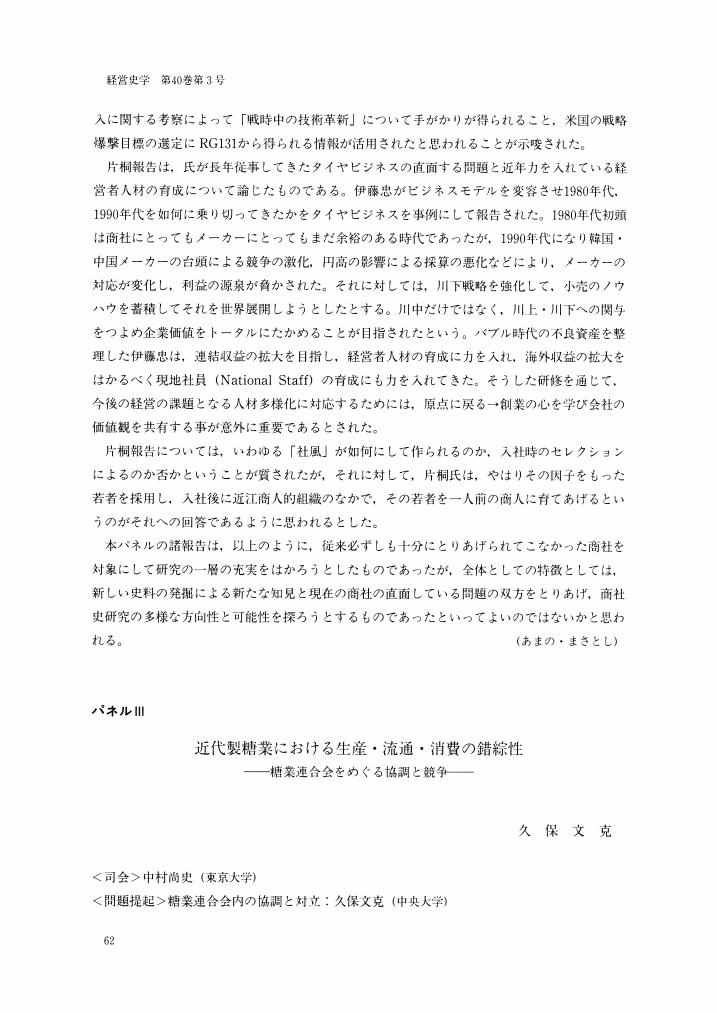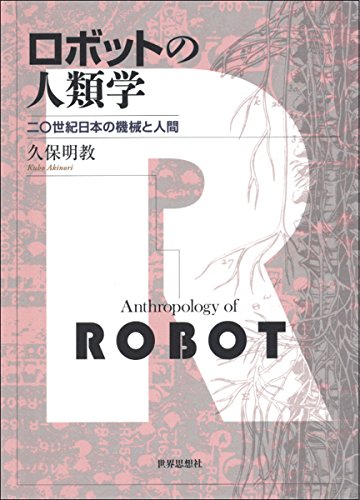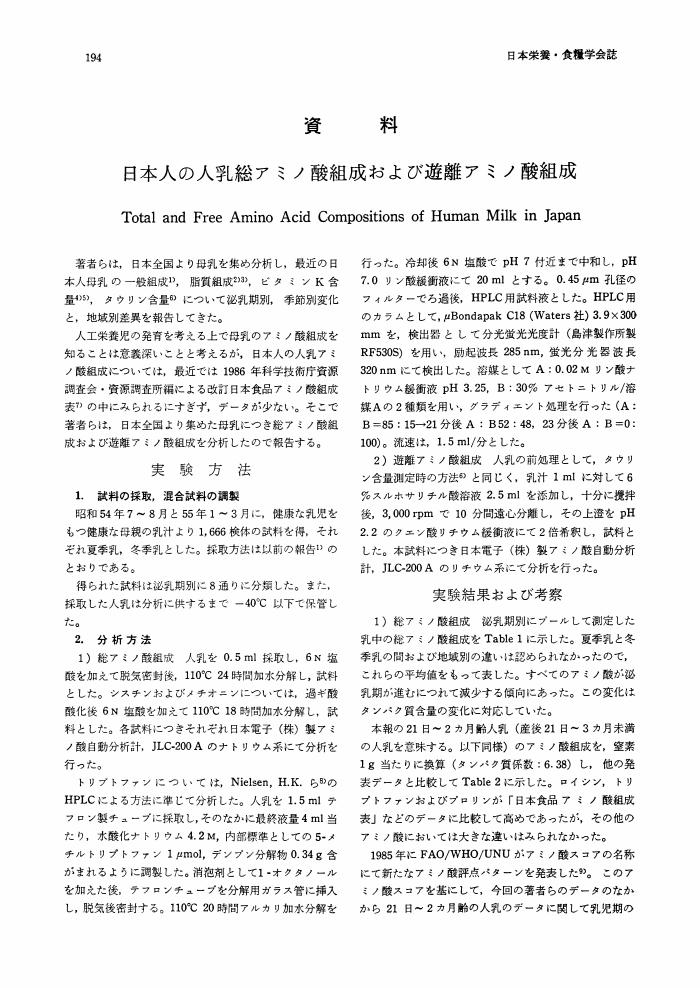1 0 0 0 OA 国策会社の経営史 台湾拓殖における国策性と営利性
- 著者
- 久保 文克
- 出版者
- 経営史学会
- 雑誌
- 経営史学 (ISSN:03869113)
- 巻号頁・発行日
- vol.42, no.4, pp.68-74, 2008-03-25 (Released:2010-05-18)
1 0 0 0 OA 近代製糖業における生産・流通・消費の錯綜性 -糖業連合会をめぐる協調と競争-
- 著者
- 久保 文克
- 出版者
- 経営史学会
- 雑誌
- 経営史学 (ISSN:03869113)
- 巻号頁・発行日
- vol.40, no.3, pp.62-66, 2005-12-25 (Released:2009-11-06)
1 0 0 0 OA 経営史教育をめぐるアンケート分析
- 著者
- 久保 文克
- 出版者
- 経営史学会
- 雑誌
- 経営史学 (ISSN:03869113)
- 巻号頁・発行日
- vol.36, no.4, pp.76-92, 2002-03-25 (Released:2010-11-18)
1 0 0 0 OA 一九九〇年の外国経営史
1 0 0 0 OA ワークショップ17 : よい研究論文の書き方
- 著者
- 山本 和利 森本 剛 徳田 安春 佐藤 寿一 牛久保 美津子 松島 雅人
- 出版者
- 一般社団法人 日本プライマリ・ケア連合学会
- 雑誌
- 日本プライマリ・ケア連合学会誌 (ISSN:21852928)
- 巻号頁・発行日
- vol.35, no.4, pp.332-340, 2012 (Released:2013-01-11)
1 0 0 0 ロボットの人類学 : 二〇世紀日本の機械と人間
1 0 0 0 OA 1930年代の中国と日中経済関係 国歌になる歌が生まれた時代
- 著者
- 久保 亨
- 出版者
- 大阪経済大学日本経済史研究所
- 雑誌
- 経済史研究 (ISSN:1344803X)
- 巻号頁・発行日
- vol.18, pp.37-61, 2015-01-31 (Released:2018-09-01)
1 0 0 0 OA 日本人の人乳総アミノ酸組成および遊離アミノ酸組成
- 著者
- 米久保 明得 小野田 敏昭 文倉 美幸 不動田 和子 山本 良郎
- 出版者
- 公益社団法人 日本栄養・食糧学会
- 雑誌
- 日本栄養・食糧学会誌 (ISSN:02873516)
- 巻号頁・発行日
- vol.42, no.2, pp.194-197, 1989-04-10 (Released:2010-02-22)
- 参考文献数
- 13
- 被引用文献数
- 2 1
1 0 0 0 OA 三島由紀夫「憂国」論 : 〈孤忠〉と〈嫉妬〉
- 著者
- 久保田 恭子
- 出版者
- 大阪府立大学日本言語文化学会
- 雑誌
- 百舌鳥国文 (ISSN:02853701)
- 巻号頁・発行日
- vol.17, pp.25-39, 2006-03-31
1 0 0 0 OA 外傷後にみられる血液凝固線溶系の変化
- 著者
- 丸藤 哲 亀上 隆 澤村 淳 早川 峰司 星野 弘勝 大城 あき子 久保田 信彦
- 出版者
- Japanese Association for Acute Medicine
- 雑誌
- 日本救急医学会雑誌 (ISSN:0915924X)
- 巻号頁・発行日
- vol.17, no.9, pp.629-644, 2006-09-15 (Released:2009-03-27)
- 参考文献数
- 47
- 被引用文献数
- 7 7
外傷後にみられる血液凝固線溶系の変化とその制御方法に関する新知見を概説した。外傷後の凝固線溶系の変化は,止血・創傷治癒のための生理的凝固線溶反応と多臓器不全(multiple organ dysfunction syndrome; MODS)を惹起して症例を死に導く病的凝固線溶反応である播種性血管内凝固症候群(disseminated intravascular coagulation; DIC)に分類される。最近外傷後DICの病型に新しい概念が導入され(controlled overt DIC and uncontrolled overt DIC),その凝固線溶系反応の経時的推移も線溶亢進期と線溶抑制期に分類して論じられるようになった。外傷後凝固線溶系反応は低体温,重症代謝性アシドーシス,希釈等の影響を受けて重篤化し出血傾向が出現するために,これらの修飾因子発現予防が症例の予後改善のために必要である。もう一つの重要な予後規定因子であるDICでは炎症性サイトカインが高値となり全身性炎症反応症候群(systemic inflammatory response syndrome; SIRS)が持続するが,このDICと遷延性SIRSが相乗的に作用して虚血性微小循環障害と炎症性微小循環障害からMODSを引き起こす。外傷後凝固線溶系の制御は,MODS発症予防と大量出血の止血を目的として行われる。前者は凝固炎症反応連関の考え方に基づいたDIC/遷延性SIRSの予防と治療が主体となり,後者においては最近の外傷後凝固線溶系反応の病態生理解明の新知見に基づいた大規模ランダム化比較試験の実施や遺伝子組み換え活性化第VII因子製剤の臨床応用等が話題となっている。
1 0 0 0 OA 尿中排泄された抗がん剤のトイレにおける飛散性に関する実験的検討
- 著者
- 佐藤 淳也 大久保 春香 佐々木 ゆうき 横井 誠 荻野 沙也佳 工藤 賢三
- 出版者
- 一般社団法人日本医療薬学会
- 雑誌
- 医療薬学 (ISSN:1346342X)
- 巻号頁・発行日
- vol.43, no.6, pp.328-335, 2017-06-10 (Released:2018-06-10)
- 参考文献数
- 17
- 被引用文献数
- 1 2
Urine containing anticancer drugs may be scattered outside the toilet bowl during urination, and these drugs may be spread when they are stepped on. The scattering of urine droplets is dependent on the shape of the toilet bowl, contact point of the urine with the toilet bowl, and the posture assumed for urination. However, this concept has not been well investigated. In this study, we investigated the scattering of urine using fluorescent dye in a urinal and a Western-style toilet.To represent urination in the standing position, we sprayed a fluorescein solution on the wall or the bottom of a urinal. We modeled urination in the standing and sitting positions in a Western-style toilet by spraying fluorescein into the toilet bowl and in three spots around the toilet bowl. The number of droplets, area, scattering distance, and scattering area around the toilet bowl were measured optically.The droplet scattering was more extensive around the toilet bowl when the liquid was aimed at the bottom of the urinal and the front edge bottom of the water in the Western-style toilet. There was no droplet scattering when using the Western-style toilet in the sitting position.If a male patient receiving chemotherapy urinates in the standing position, the anticancer drug will spread through scattered urine and become an environmental pollutant. Therefore, it is important to instruct male patients to urinate in a sitting position when using a Western-style toilet.
- 著者
- 久保田 貢
- 出版者
- 日本社会科教育学会
- 雑誌
- 社会科教育研究 (ISSN:09158154)
- 巻号頁・発行日
- vol.2007, no.102, pp.25-36, 2007 (Released:2016-12-01)
1 0 0 0 OA 価格改革
- 著者
- 久保庭 真彰
- 出版者
- 比較経済体制学会
- 雑誌
- 社会主義経済学会会報 (ISSN:18839789)
- 巻号頁・発行日
- vol.1989, no.27, pp.15-17, 1989-11-20 (Released:2009-07-31)
1 0 0 0 OA ソ連における社会主義経済学ペレストロイカの位相 1つの中間報告
- 著者
- 久保庭 真彰
- 出版者
- 比較経済体制学会
- 雑誌
- 社会主義経済学会会報 (ISSN:18839789)
- 巻号頁・発行日
- vol.1988, no.26, pp.3-9, 1988-11-20 (Released:2009-07-31)
- 参考文献数
- 7
- 被引用文献数
- 1
1 0 0 0 OA ラウンドテーブル「体制転換と数量経済分析」 新しい問題とその解決の展望
- 著者
- 田畑 伸一郎 吉井 昌彦 久保 庭真彰 名島 修三
- 出版者
- 比較経済体制学会
- 雑誌
- 比較経済体制学会会報 (ISSN:18839797)
- 巻号頁・発行日
- vol.1993, no.31, pp.53-58, 1993-10-15 (Released:2009-07-31)
- 著者
- 大久保 遼
- 出版者
- Japan Society of Image Arts and Sciences
- 雑誌
- Iconics (ISSN:13454447)
- 巻号頁・発行日
- vol.11, pp.7-26,57, 2014-04-10 (Released:2019-08-08)
- 参考文献数
- 55
This article analyzes the magic lantern show and its spectators during late nineteenth-century Japan, through an examination of two types of lantern shows and their different spectators. In Japan, magic lanterns (gentô) began to be used as an educational tool during lectures in elementary schools in the late 1880s. During these educational lantern shows (Kyôiku gentô kai), the devices, the lecture's explanation and the instructions were managed in such a way that the students were encouraged to concentrate on the projected images in silence. However, during Sino-Japanese War lantern shows (Nisshin sensô gentô kai), which were held between 1894 and 1895, the spectators clapped their hands, shouted banzai, sang military songs, and even played music instruments. In addition, the role of the benshi in the Sino-Japanese War lantern shows was different to that of the lecturer who merely gave instructions using slides and textbooks in the educational lantern shows. Indeed, the benshi's skill in narrating and performing had a direct effect on the spectators' emotions and reaction. Moreover, auditory stimuli such as music, songs, and narration all helped to keep their attention during the shows. These two types of lantern shows were completely different in terms of the spectators' reaction. However, they were similar in that they were both organized to produce a homogeneous reaction by managing the spectators' perception.
1 0 0 0 OA Kinodrama and Kineorama:
- 著者
- 大久保 遼
- 出版者
- Japan Society of Image Arts and Sciences
- 雑誌
- Iconics (ISSN:13454447)
- 巻号頁・発行日
- vol.10, pp.75-95, 2010-03-31 (Released:2019-08-07)
- 参考文献数
- 51
1 0 0 0 OA シグナル伝達機構による時間情報コード
- 著者
- 久保田 浩行 黒田 真也
- 出版者
- 一般社団法人 日本生物物理学会
- 雑誌
- 生物物理 (ISSN:05824052)
- 巻号頁・発行日
- vol.53, no.4, pp.184-189, 2013 (Released:2013-07-25)
- 参考文献数
- 18
Cellular responses, such as cell fate decision and hormonal regulations, can be regulated by distinct temporal patterns of signaling molecules. However, how temporal patterns of signaling molecules determine the cellular responses remains largely unknown. Recently, we have proposed the concept of “temporal coding”, by which a single molecular species can encode multiple information through its temporal patterns. We found that signaling pathways can process information of stimulation patterns depending on their network motif and kinetics, and cells can regulate downstream molecules depending on stimulation pattern. Thus, “temporal coding” appears to serve as an information-embedding strategy to elicit specific cellular responses.
- 著者
- 久保田 芳久
- 出版者
- 誠文堂新光社
- 雑誌
- 農耕と園芸 (ISSN:13458833)
- 巻号頁・発行日
- vol.60, no.6, pp.48-51, 2005-06
1 0 0 0 OA 美的・倫理的人間形成論の現在性をめぐって
- 著者
- 白銀 夏樹 村田 美穂 久保田 健一郎 奥野 佐矢子 小野 文生
- 出版者
- 教育哲学会
- 雑誌
- 教育哲学研究 (ISSN:03873153)
- 巻号頁・発行日
- vol.2006, no.93, pp.145-150, 2006-05-10 (Released:2010-01-22)
- 参考文献数
- 9
現代の人間形成論においては、「美」「倫理」という言葉によって、人間形成をめぐる現代的状況を解明しようとする議論や人間形成論の可能性を提起しようとする議論が少なからず見受けられる。だが「美」と「倫理」の概念の接点をさぐりながら人間形成論の現代的射程を探る共同研究の試みは、いまだ豊かに展開されているとはいいがたい。教育哲学会第四八回大会 (香川大学) において「美」と「倫理」の概念に関心を寄せる若手研究者が集まり、「美的・倫理的人間形成論の現在性をめぐって」と題したラウンドテーブルを開催した。ドイツ語圏の美的人間形成論 (白銀・久保田) 、英語圏の道徳や倫理を扱う人間形成論 (奥野・村田) 、ドイツ教育思想史における「美」「倫理」概念 (小野) といった各々の関心から、現代の「美」「倫理」概念の人間形成論的射程を議論した。以下はラウンドテーブル当日の提案者四名 (村田、久保田、奥野、白銀) と指定討論者 (小野) による報告である。本論の最終的な文責は企画者 (白銀) が負うが、それぞれの項目は担当者が執筆したものである。











